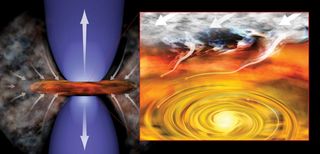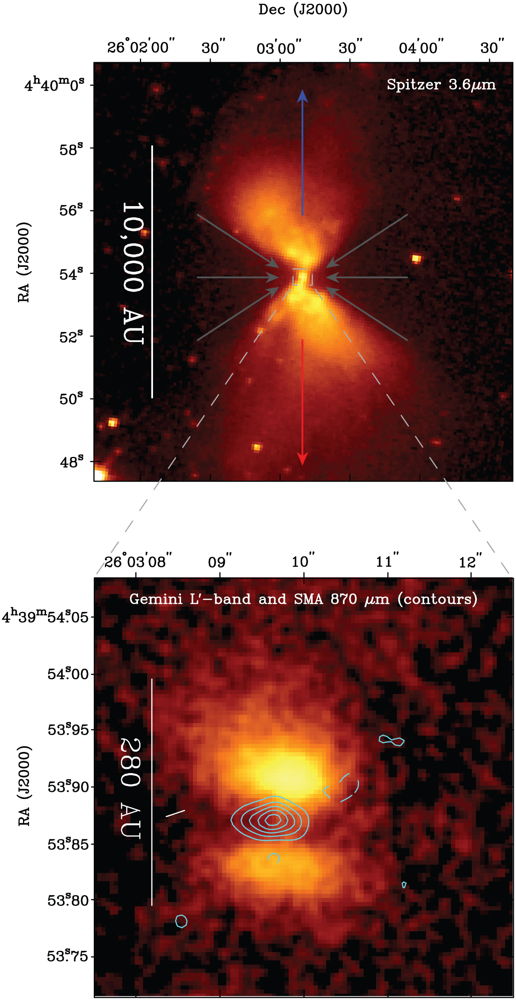Image of a Protostar Image of a Baby Star
Baby Star Caught in the Act of Growing

Beneath a dusty disk of cosmos, a baby star'southward mass has been measured for the beginning time.
The star, called L1527 IRS, is only one-5th the mass of the lord's day, and is expected to proceed growing as the swirling disk of matter surrounding it falls into its surface.
Astronomers estimated the star formed around the same time that Neanderthals evolved on Globe: just 300,000 years ago.
In fact, if L1527 had grown in mass just a flake more speedily in its earlier years, information technology could be equally young every bit 150,000 years former. Either style, the star is among the youngest discovered in the universe, said lead researcher John Tobin.
"There'due south 5 times more material surrounding it that could be incorporated in [the star]," said Tobin, a Hubble swain at the National Radio Astronomy Observatory in Virginia. "There is however a lot of room to abound, so to say."
Birth of a solar organisation
L1527 lies in the constellation Taurus, about 450 light-years from Globe. Its shut distance makes it easier to resolve fine features in the disk. [Video: Nursery of Baby Stars Spotted Past Chandra]
Mostly, a star forms from a deject of gas that collapses into itself. Material streams in from the cloud and forms a protostar in the centre of a deejay of gas and dust.
Over millions of years, material falls on the protostar and releases quite a bit of energy. In L1527, 90 percentage of its energy comes from material landing on the surface of the protostar. The remaining 10 percent comes from the star itself.
"There is a rotationally supported deejay effectually this protostar," said Tobin, adding information technology's a "fundamental chemical element" in building planets. "It lets the material hang out long enough for the planet formation process."
But information technology'due south far too early in L1527's evolution to talk virtually protoplanets, he added. In the calibration of stellar development, the star is at Stage 0. By comparison, Earth'due south sun is a middle-aged matron, at four.6 billion years of age.
Mass measurements

Astronomers measured L1527'southward mass through simple Newtonian physics: They determined the mass by calculating the speed of the affair swirling around the protostar at a given distance.
Tobin, who has been watching this star for several years, said L1527 could serve as a useful goalpost in humans' understanding of stellar evolution.
Information technology appears that xc percent of immature stars that are less than ane meg years old have disks of matter surrounding them. Save for the few in multiple-star systems who see their disks diddled away, it appears disk formation is a universal procedure in a young star'southward life.
Tobin was granted telescope fourth dimension at the Atacama Large Millimeter/submillimeter Array (ALMA) in Chile, which is a new radio telescope array that reveals a universe not seen in visible and infrared light.
"We want to become a more detailed view of the construction of the rotating disk," he said, adding, "Nosotros're also trying to expect at more young protostars to observe more disks like this. Y'all can get a big motion picture view of everything that'south going on."
The enquiry will be published in the Dec. 6 issue of the journal Nature and includes collaborations with astronomers in the Us, Germany and United mexican states.
Follow Elizabeth Howell @howellspace, or Infinite.com @Spacedotcom. We're likewise on Facebook and Google+.
Bring together our Infinite Forums to keep talking space on the latest missions, night sky and more than! And if you have a news tip, correction or annotate, let usa know at: community@space.com.
albersdittleatized.blogspot.com
Source: https://www.space.com/18774-baby-protostar-growing.html

0 Response to "Image of a Protostar Image of a Baby Star"
Post a Comment